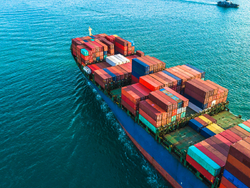Combatting Covid-19 with containers

Box shipping can provide a vital supply chain for vaccines but will need to work closely with manufacturers to meet regulatory compliance requirements.
Container shipping can provide a cost-effective way of distributing vaccines to low-income countries. But it will take time to convince pharma companies that it is up to the job
WITH 150,000 vials of coronavirus vaccine fitting into a single container, it would be possible to ship enough doses to protect the entire world on just a handful of ultra-large containerships.
The challenge, however, is far more difficult than that and to date, the vaccines that have been exported from their countries of manufacture have moved by either road or air.
But there are hopes that container shipping can have a role in the distribution of the world’s coronavirus vaccines.
“Given the sheer scale of the exercise of getting the majority of the world vaccinated, and the demands these vaccines will place on finite, temperature controlled airfreight capacity, our view is that ocean shipping is likely to play a prominent role in the distribution of the less temperature sensitive coronavirus shots,” said PSA International vice-president for cargo solutions Siddharth Adya.
Speaking at a Cool Logistics webinar, Mr Adya noted that ocean freight would help reduce the costs of transport, particularly for the developing world, and that the associated inventory of consumables such as syringes and personal protection equipment were already shipped by sea.
“To that extent, we believe containers can and will play a critical role in the medium term,” he said.
Michael Culme-Seymour, a consultant with the World Economic Forum and vice-president of shipment tracking service Roambee, said that with a target price of $3-$5 per dose, transport could add 30%-40% to the costs of vaccines.
“We have to find ways to ship them more cost effectively,” he said.
“If we can start on some small trade lanes, such as India to Southeast Asia, and get the systems and equipment in place, people can start to gain confidence that ocean works.”
But while the box shipping sector is already experienced in shipping vaccines, there was work to do before pharmaceutical companies would entrust such shipments to ocean freight.
“Speed is the key at the moment, so road and air are dominating,” said DHL Global Reefer Competency Centre director Sebastian Steinmüller.
“There are opportunities, but there are a lot of challenges. The industry has already proved it can move pharmaceuticals but not every trucking company might have the experience of delivering reefer containers in a compliant way.”
Nevertheless, huge volumes of supporting products going on ocean already and in some niche trades, like intra-Europe and intra-Asia would definitely see vaccines going by ocean, he added.
“But the vaccination ratios will have to reach a certain level before this will be common.”
A key element of any ocean transport of vaccines will be data transparency and regulatory compliance.
“Sharing of critical logistics and product information as quickly as possible will be important so that events can be flagged,” Mr Adya said.
“This will also be important to avoid time lags when shipments arrive at port and need to be quickly entered into the vaccine supply chain. By providing timely and steady fulfilment of vaccines and PPE we can minimise the need for handling at destinations that maybe do not have the equipment or infrastructure.”
Visibility will also be important from a carrier perspective, according to Maersk head of pharmaceuticals and healthcare Hristo Petkov, particularly given the requirement for refrigerated containers, which are also in short supply.
“We can get the containers to the customer but the demand needs to be forecast,” he said.
“If a pharma company asked for 50 containers tomorrow, it would be very hard to find them and it might have to come at the expense of someone else.”
Matching supply with demand is perhaps one of the biggest problems container shipping will face with distributing vaccines.
“The delays from Suez and on the US west coast mean there is an absolute lack of confidence,” Mr Culme-Seymour said.
Prioritising the global distribution of vaccines would require relationships with producers, rather than just transactional interactions, Mr Petkov added.
“Convincing pharma to move to ocean will be a long process that requires quality commitments to be in place,” Mr Steinmüller said.
“The switch from air to ocean will be a process. Equipment availability is simply not going to be able to keep up as we move into less developed countries. Mindsets will have to change. But we will also have to look at how data is shared and how we priorities vaccine deliveries by sharing information across the supply chain.